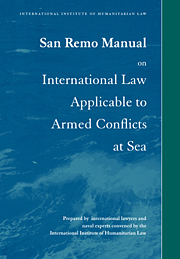 San Remo Manual on International Law Applicable to Armed Conflicts at Sea
San Remo Manual on International Law Applicable to Armed Conflicts at Sea Book contents
- Frontmatter
- Contents
- FOREWORD
- SAN REMO MANUAL
- EXPLANATION
- Introduction
- List of abbreviations
- Part I General provisions
- Part II Regions of operations
- Part III Basic rules and target discrimination
- Part IV Methods and means of warfare at sea
- Part V Measures short of attack: interception, visit, search, diversion and capture
- Part VI Protected persons, medical transports and medical aircraft
- INDEX
Introduction
Published online by Cambridge University Press: 04 August 2010
- Frontmatter
- Contents
- FOREWORD
- SAN REMO MANUAL
- EXPLANATION
- Introduction
- List of abbreviations
- Part I General provisions
- Part II Regions of operations
- Part III Basic rules and target discrimination
- Part IV Methods and means of warfare at sea
- Part V Measures short of attack: interception, visit, search, diversion and capture
- Part VI Protected persons, medical transports and medical aircraft
- INDEX
Summary
Background
The San Remo Manual was prepared during the period 1988–94 by a group of legal and naval experts participating in their personal capacity in a series of Round Tables convened for this purpose by the International Institute of Humanitarian Law. A preliminary Round Table on International Humanitarian Law Applicable to Armed Conflicts at Sea, held in San Remo in 1987 on the initiative of the International Institute of Humanitarian Law, in co-operation with the University of Pisa and the University of Syracuse in New York, discussed the need for a modernisation of the law applicable to armed conflicts at sea. The Declaration adopted at that meeting noted that:
new technologies and methods of warfare, new developments in the law of armed conflict and in the law of the sea and the increased possibilities of grave harm to the environment as a result of armed conflict at sea, require study in the light of the principles [of international law applicable in armed conflict] …
It was only in the subsequent meeting at Madrid, convened by the International Institute of Humanitarian Law with the support of the Spanish Red Cross in 1989, that participants decided on a plan of action to study systematically these issues and to draft a restatement of the contemporary law applicable to armed conflicts at sea together with some proposals for progressive development.
- Type
- Chapter
- Information
- San Remo Manual on International Law Applicable to Armed Conflicts at SeaInternational Institute of Humanitarian Law, pp. 61 - 70Publisher: Cambridge University PressPrint publication year: 1995
- 1
- Cited by


